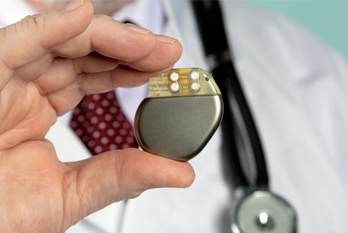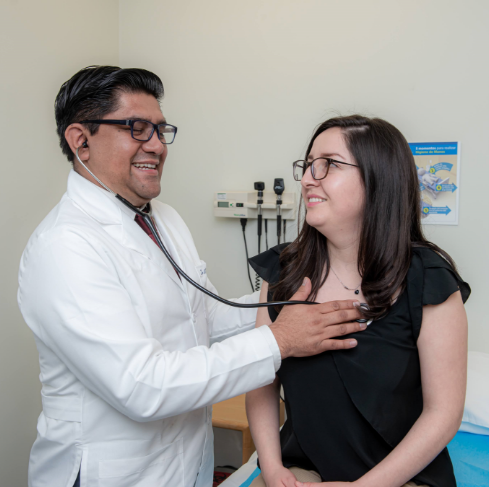Pacemaker Clinic
In the pacemaker clinic, alterations in the heart rhythm are measured, whether they are rapid (tachyarrhythmias) such as atrial fibrillation or paroxysmal supraventricular tachycardia and slow (bradyarrhythmias) such as sinus node dysfunction or atrioventricular blocks (heart block).
For certain types of arrhythmias, a pacemaker is recommended, a small device that is implanted under the skin of the chest and sends electrical signals to the heart to maintain a normal rhythm.
Some of the most frequent ailments that occur in the Pacemaker Clinic are:
- Arrhythmias
- Bradycardia
- Rhythm disorders (prolonged QT)
Some of the most frequent procedures that we attend in the Pacemaker Clinic are the following:
Cardiac ablation
Cardiac ablation is a procedure that aims to remove (through precise destruction and scarring) the small areas of the heart that cause or sustain an irregular rhythm.
CARTO team
The CARTO electroanatomic system uses an integrated mapping catheter with a location sensor incorporated into its tip to allow automatic and simultaneous acquisition of the electrogram of that position and its three-dimensional location coordinates. It acquires the location of the catheter tip electrode along with its local electrogram and reconstructs a color-coded three-dimensional electroanatomic map of the cardiac chamber with relevant, real-time electrophysiological information.
Equipo CARTO
Gracias al equipo CARTO, vía un catéter, obtenemos en tiempo real la imagen 3D del corazón del paciente e información electrofisiológica relevante para realizar una operación más exitosa.
Cardioversion
Cardioversion is a medical procedure that restores a normal heart rhythm in people who have certain types of abnormal heartbeats (arrhythmias). It is often done by delivering electrical shocks to the heart through electrodes that are placed on the chest.
Pacemaker
Pacemakers are used to regulate the heart’s rate. Your specialist might recommend pacemaker implantation when you have slow heartbeats (bradycardia), after a heart attack or heart failure, among others.
At the Cardiovascular Center we offer you a wide range of prevention, diagnosis, timely treatment and follow-up services to take care of your heart and that of your loved ones
La ablación cardíaca es un procedimiento que permite solucionar problemas en el ritmo cardíaco (arritmias); funciona mediante la cicatrización o destrucción del tejido del corazón que provoca o sostiene el ritmo cardíaco anormal. En algunos casos, la ablación cardíaca evita que las señales eléctricas anormales ingresen al corazón y, de este modo, detiene la arritmia. Se utilizan tubos largos y flexibles (catéteres) que se introducen a través de una vena o arteria en la ingle y se deslizan hasta el corazón con el fin de aplicar energía en forma de calor o frío extremo para modificar los tejidos del corazón que provocan una arritmia.
La ablación cardíaca a veces se realiza mediante una cirugía a corazón abierto, pero se suelen utilizar catéteres, de esta manera, el procedimiento resulta menos invasivo y se acorta el tiempo de recuperación.
Equipo CARTO
El sistema electroanatómico CARTO utiliza un catéter de cartografía integrado con un sensor de localización incorporado en su punta para permitir la adquisición automática y simultánea del electrograma de esa posición y sus coordenadas de localización tridimensional. Adquiere la localización del electrodo de la punta del catéter junto con su electrograma local y reconstruye un mapa electroanatómico tridimensional de la cámara cardíaca codificada en color, con información electrofisiológica relevante y en tiempo real.
Gracias al equipo CARTO, vía un catéter, obtenemos en tiempo real la imagen 3D del corazón del paciente e información electrofisiológica relevante para realizar una operación más exitosa.
Faint Clinic.
Faint is a sudden and brief loss of consciousness with absence of postural tone followed by spontaneous recovery. The patient is immobile and flaccid and generally has cold limbs, a weak pulse, and shallow breathing. Brief involuntary muscle jerks sometimes occur, resembling a seizure.
Structural intervention clinic (valve)
We have doctors who specialize in heart disease (cardiologists), heart surgery (cardiac surgeons), and other specialists who collaborate to evaluate your condition. Interventional and diagnostic imaging specialists in cardiology work together to assist you according to your needs.
Transcatheter Aortic Valve Implant (TAVI)
The transcatheter aortic valve implant has become the treatment of choice for patients with severe aortic stenosis considered inoperable or at high surgical risk, with better results than with conservative management, including aortic valvuloplasty.
What is a valve disease?
Every time the heart beats, blood enters the heart, circulates through it, and then leaves. Moreover, the heart pumps about 100 gallons (379 liters) of blood into the body every hour. Two types of problems can alter the flow of blood through the valves: regurgitation and stenosis.
Regurgitation
Is also called “insufficiency” or “incompetence”. Regurgitation occurs when a valve does not close properly and allows blood to leak backward, rather than flow, in a unidirectional manner, as it should. If too much blood flows backward, only a small amount of blood can flow to the organs of the body. The heart tries to compensate by working harder, but over time the heart enlarges (dilates) and its ability to pump blood to the body decreases.

Stenosis
Is when the leaflets do not open wide enough and only a small amount of blood can pass through the valve. Stenosis occurs when the leaflets thicken, harden, or fuse together. Due to the narrowing of the valve, the heart must work harder to pump blood to the body.
Some of the most common conditions that occur in the valve clinic are:
- Congenital heart disease
- Structural heart diseases
- Acute coronary syndromes
At the Cardiovascular Center we offer you a wide range of prevention, diagnosis, timely treatment and follow-up services to take care of your heart and that of your loved ones
Heart Failure Clinic
Heart failure occurs when the heart muscle does not pump blood as well as it should. Certain conditions, such as narrowed arteries in the heart (coronary artery disease) or high blood pressure, progressively leave the heart too weak or stiff to fill and pump effectively. Not all conditions that cause heart failure can be reversed, but treatments can improve the signs and symptoms of heart failure and help you live longer.
Lifestyle changes (such as exercising, reducing sodium in your diet, managing stress, and losing weight) can improve your quality of life. One way to avoid heart failure is to prevent and control the conditions that cause it, such as coronary artery disease, high blood pressure, diabetes, or obesity.
Rehabilitación Cardíaca Ofrecemos un tratamiento individualizado de acuerdo con tu capacidad funcional.
La rehabilitación cardiaca comprende de una serie de actividades físicas, relajación y educación para la modificación de factores de riesgo, encaminadas a la prevención secundaria, como una forma de limitar el daño y mejorar la calidad de vida.
En el Centro Médico ABC desarrollamos un programa de rehabilitación cardiaca que puede mejorar la capacidad de funcionamiento de tu corazón, retomando una vida productiva y satisfactoria disminuyendo el nivel de estrés, aumentando tu confianza y las ganas de vivir además de reducir la incidencia de eventos cardiovasculares.
Qué logros obtendrás con un programa de rehabilitación cardíaca
- Mejora tu capacidad física.
- Crea hábitos de ejercicio.
- Modificación de los factores de riesgo.
- Mejora el nivel lipídico.
- Controla tu peso corporal.
- Controla la glucemia.
- Controla la tensión arterial.
- Controla o elimina el consumo del tabaco.
- Reducir el estrés, ansiedad y depresión.
Qué logros obtendrás con un programa de rehabilitación cardíaca
- Post infarto agudo al miocardio.
- Postoperatorio de bypass.
- Angina de pecho estable.
- Trasplante cardíaco o de pulmón.
- Postoperatorio de angioplastia o cirugías valvulares.
- Miocardiopatías.
- Arritmias cardíacas.
- Marcapasos.
- Insuficiencia cardiaca.
- Postoperatorio de angioplastia con o sin stent.
- Postoperatorio de cateterismo cardíaco.
Our Locations
At ABC Medical Center, we are prepared to serve you in out two Campuses 24/24h, 7 days a week.
Campus Observatorio
Sur 136 No. 116, Col. Las Américas,
Álvaro Obregón, 01120, Cd. de México.
Tel. 55 5230 8000
Campus Santa Fe
Av. Carlos Graef Fernández 154, Col. Santa Fe,
Cuajimalpa, 05300, Cd. de México.
Tel. 55 1103 1600






